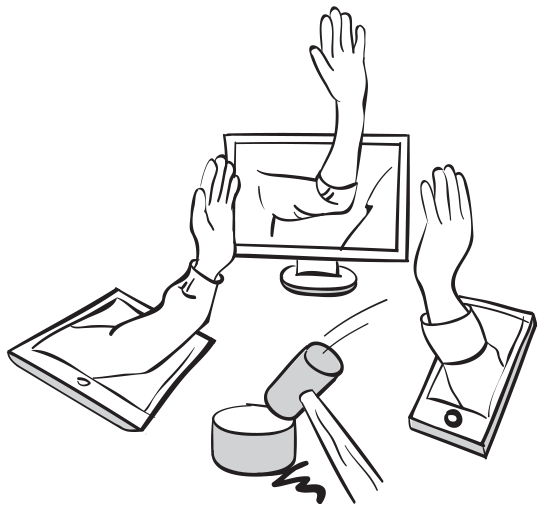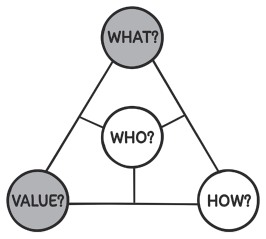Auction
Going once, going twice... sold!

The pattern
The Auction business model is based on participative pricing: in other words, the price of a product is not determined by the vendor alone, but buyers actively influence the final price of the goods or services. Finding a price starts with a potential buyer bidding a certain amount based on his or her willingness to pay. When the auction is over, the customer who has made the highest bid is committed to purchasing the product or service.
From the point of view of buyers, the chief advantage is that they never have to spend more than they can afford or are willing to pay (WHAT?). The advantage for the vendor is that products can be allocated more efficiently across the market (VALUE?). This feature is particularly valuable for very rare or heterogeneous products without reference prices, or for which demand is difficult to determine. In order to ensure that vendors are not obliged to sell their products below what they consider to be an acceptable threshold, it has become customary in some cases to set a reservation price (VALUE?), but the selling price for a given item or service does not become fixed until the auction has ended.

The origins
Auctions are age-old business models still used on today’s auction markets, such as those for animals. In the business world, auctions have become popularised by the development of auction houses. One of the oldest and most historic auction houses is Sotheby’s, which was founded in London in 1744 by bookseller Samuel Baker. The company’s first-ever auction was undertaken by Baker himself on 11 March 1744 with a view to liquidating several hundred valuable books at a profit. From there the business quickly expanded to include the auctioning of medals, coins and prints.
The Internet opened up an important new era for this business model. The Web makes it possible for auctions to take place with no limitation of physical space, so that they are now accessible to a vastly larger audience than before. One of the pioneers in this area is the online auction site eBay, through which people and businesses sell a wide variety of goods and services worldwide. Vendors set up a page on the website with a description of the product they wish to auction off, and interested buyers then bid for the product. As of 2019, eBay has more than 183 million active users, making it by far the largest auction house in the world.
Auction: timeline

The innovators
Side by side with eBay, the Auction pattern has been applied in other innovative ways to business models in recent years. Auctionmaxx is a Canadian online liquidator of unclaimed, misguided or damaged freight, retail surpluses and insurance claims. Launched in 2012, the auction site introduced a simple yet convenient concept: Auctionmaxx offers its customers the combined benefits of a 24/7 online shopping platform, one single pick-up location for all auctioned items and, if desired, advice from liquidation experts. Users save additional money since the products on auction are offered without any bidding reserves, buyer’s premiums or pick-up fees.
Other examples of the Auction pattern build on the concept of ‘reverse’ auctions, also known as procurement auctions. The Reverse Auction is a variant of the traditional Auction, whereby vendors bid for a contract rather than buyers bidding on a product. Priceline, founded in 1997, is a well-known and very successful reverse auction house that focuses on travel-related services. In this model, the customer specifies his or her preferences for a given travel itinerary (flight, hotel, rental car, etc.) and may also state the maximum price they are willing to pay for the trip. On the basis of this offer, Priceline searches for bids that conform to the customer’s specifications among its partners within the network. Submitting an offer commits the customer to purchase the corresponding offer proposed by Priceline. Despite a certain degree of risk for the customer, Priceline’s business model is a thriving one: in 2018, just after The Priceline Group was renamed Booking Holdings, the company had 24,500 employees and a worldwide turnover of US $14.5 billion.
Another company that has applied the Auction business model successfully is MyHammer. The company was established in 2005 and specialises in reverse auctions for tradespeople and related service contracts. As with Priceline, MyHammer customers state the kind of services they require, which may include anything from small repairs, through relocation, to entire construction projects. The Auction business model enabled MyHammer to become one of the leading marketplaces for tradespeople and service contracts within a very few years. It is estimated that over €100 million worth of contracts have been auctioned off on MyHammer.
A highly successful way of using Auction has been introduced by Google Ads, Google’s proprietary advertisement offering. Each time an ad is eligible to appear in search results, it goes through a theoretical auction that determines if and at which position it will be shown to the searching customer. The outcome of the auction depends on three factors: (1) the advertiser’s bid, which means the maximum amount he or she is willing to pay per click from the ad; (2) the quality of the ad considered, which depends on how relevant and useful the ad and the website it represents are to the searching customer; and (3) the expected impact of the ad, which comes from additional information such as relevant keywords. Showing a quasi-monopoly in the search-engine advertisement world, in 2018 Google’s advertisement revenue amounted to more than US $116 billion.
When and how to apply Auction
The Auction pattern’s allure and potential lie in its flexibility and vast possibilities for implementation. You can either offer your own products, or create a marketplace for sellers and buyers available to all sorts of products (think of eBay) or targeted towards niche products. In general, the Auction business model is highly scalable and can serve millions of users around the clock. These users invariably benefit from the network effect this scenario creates. The pattern works well if an auction creates more transparency for standardised products, such as C-parts or raw material. Auction is also geared towards selling highly specialised products, provided the auction site attracts sufficient traffic.
Some questions to ask
- How can we achieve a unique selling proposition that will allow us to steal customers from the big established players, such as eBay and Alibaba?
- Can we generate high reach for market players?
- How do we maintain a competitive advantage in a highly competitive landscape?
- How can we ramp up the number of market players quickly and efficiently?
- How can we uphold our reputation and certify that transactions are completed correctly?
